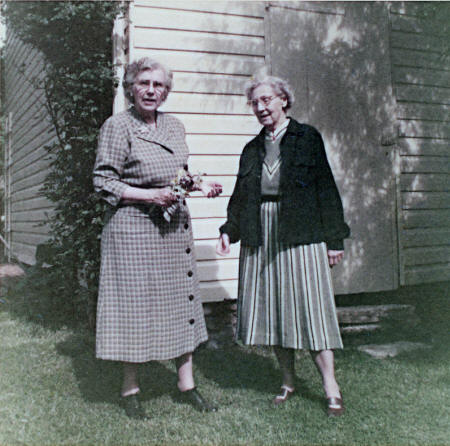

Partner Virginia Robinson
Queer Places:
Hull House, 800 S Halsted St, Chicago, IL 60607
The Pocket, 15 E Mill Rd, Flourtown, PA 19031
 J.
(Julia) Jessie Taft (June 24, 1882 in Dubuque,
Iowa – June 7, 1960 in Flourtown,
Pennsylvania) was an early American authority on child placement and
therapeutic adoption. The sociologists Virginia Robinson
and her lifelong companion Jessie Taft were hired by the prison reformer
Katharine Bement Davis
to undertake research on female criminals: their partnership lasted more than
50 years and included two adopted children.
J.
(Julia) Jessie Taft (June 24, 1882 in Dubuque,
Iowa – June 7, 1960 in Flourtown,
Pennsylvania) was an early American authority on child placement and
therapeutic adoption. The sociologists Virginia Robinson
and her lifelong companion Jessie Taft were hired by the prison reformer
Katharine Bement Davis
to undertake research on female criminals: their partnership lasted more than
50 years and included two adopted children.
Educated at the University of Chicago, Taft spent the bulk of her professional life at the University of Pennsylvania, where she and Virginia Robinson were the co-founders and innovators of the functional approach to social work. Taft is the author of The Dynamics of Therapy in a Controlled Relationship (1933). She is also remembered for her work as the translator and biographer of Otto Rank, an outcast disciple of Sigmund Freud;; in addition, development of the functional approach to social work was greatly inspired by her work with Rank.

Jessie Taft with lifelong companion Virginia Robinson in May 1954 by their home, "The Pocket", in Flourtown, Pennsylvania

Jessie Taft with family in 1923. (L-R)Jessie, Martha, and Everett Taft, Virginia Robinson. Everett was adopted in 1921, Martha in 1923.
Jessie Taft was born Julia Jessie Taft on June 24, 1882 in Dubuque, Iowa, the oldest of three sisters. Her parents were Charles Chester Taft and Amanda May Farwell who moved from Vermont to Iowa. There is no known connection to the famous offspring of the Vermont Tafts. Her father established a prosperous wholesale fruit business in Des Moines. Her mother was a homemaker who gradually became deaf and distant from her daughters.[1] Taft attended and graduated from West Des Moines High School. She then went to Drake University in Des Moines, Iowa and received a B.A. degree in 1904. Also in her class of 1904 at Drake was Clara Charlotte Hastings, granddaughter of Pardee Butler and older sister of Milo Hastings. Two decades later Taft was to adopt a boy, Everett, the first-born son of Milo Hastings and Frances Horowitz. There is no evidence that Taft realized she was adopting the nephew of a former college classmate. After college at Drake, Taft went to the University of Chicago and earned a Ph.B. in 1905. She then went back to Des Moines to her former high school and taught there for four years. In 1908 she returned to the University of Chicago for graduate work. At that time she met Virginia P. Robinson. The two women became lifelong companions and colleagues. In 1909 she got a fellowship and began working with George H. Mead (who became her thesis adviser), James Hayden Tufts, and William I. Thomas. She also worked at Hull House, the social settlement of Jane Addams. Taft completed her doctoral thesis "The Woman Movement from the Point of View of Social Consciousness" in 1913. It was published in book form in 1916. In 1912, Taft found work at The Bedford Hills Reformatory for Women in New York City and stayed there until 1915. She then practiced psychology for four years before becoming director of the Child Study Department of the Children's Aid Society in Pennsylvania. Taft and Robinson moved to Flourtown, Pennsylvania close by Carson Valley School, where they were close friends with the staff. Taft, the school and its staff appear in the novel Double Stitch by John Rolfe Gardiner. In about 1920 Taft and Robinson bought a house on East Mill Road in Flourtown that became known as "The Pocket", so called because the women had to dig deeply into their pockets to purchase the property.[2] In 1921, the Taft and Robinson made the decision to adopt two children. Everett was adopted on his birthday July 9, 1921 at age nine. Martha Scott was adopted in 1923 at age 6. Everett went on to marry and raise a family. Martha, who never married, became Chief Dietitian for the Veterans Administration Hospital in Philadelphia.[3] In 1924, Taft met Otto Rank, an outcast disciple of Sigmund Freud, and became his American champion and translator. Taft was finally able to begin an academic career in 1929 at the University of Pennsylvania. In 1934 she became the director of their new school of social work. She retired in 1950 to organize Rank's papers (he died in 1939) which were donated to Columbia University, and to write his biography which was published in 1958. E. James Lieberman wrote another biography of Rank in 1985 with many references to Taft. Taft died on June 7, 1960, in Flourtown, Pennsylvania, after suffering a stroke. Virginia Robinson lived on until 1977, writing a biography of Taft that came out in 1962.
My published books: